Practice with the help of enVision Math Common Core Kindergarten Answer Key Topic 8 More Addition and Subtraction regularly and improve your accuracy in solving questions.
Envision Math Common Core Grade K Answers Key Topic 8 More Addition and Subtraction
Essential Question: How can solving problems in more than one way help you learn about addition and subtraction?
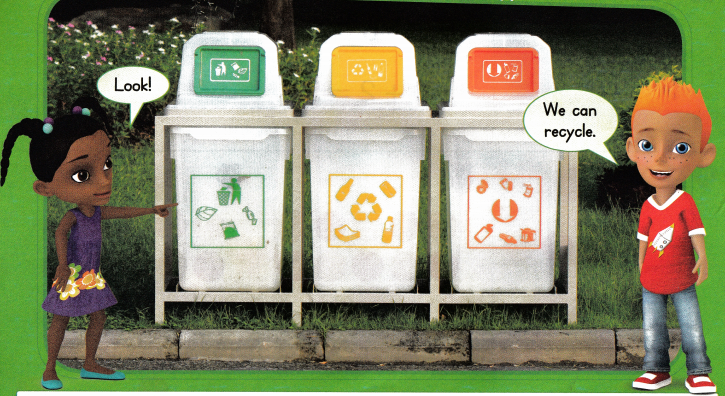
Directions Read the character speech bubbles to students. Find Out! Have students find out about the impact of littering and how recycling reduces human impact on the environment. Say: Talk to friends and relatives about the items they recycle. Ask them how they are helping to protect the environment. Journal: Make a Poster Then have students make a poster. Ask them to draw a playground littered with 4 paper, 3 plastic, and 2 metal recyclables. Have them draw a circle around the papers in green, the plastics in yellow, and the metals in orange. Finally, have students write an equation that adds the 4 paper and 3 plastic recyclables together.
Review What You Know
Directions Have students: 1 draw a circle around the difference; 2 draw a circle around the subtraction equation and mark an X on the addition equation; 3 draw a circle around the minus sign; 4 and 5 count the counters, and then write the number to tell how many; 6 count the counters, and then write the numbers to tell the parts.
Question 1.
7 – 5 = 2
Answer:

Explanation:
I circled 2, it is the difference of 7 and 5.
Question 2.
8 – 6 = 2
3 + 2 = 5
Answer:

Explanation:
I circled the subtraction equation and marked X on the addition equation.
Question 3.
+ –
Answer:

Explanation:
I circled the symbol minus(-).
Question 4.

Answer:

Explanation:
I counted the counters, they are 5 in number.
Question 5.

Answer:

Explanation:
I counted the counters, they are 10 in number.
Question 6.

Answer:
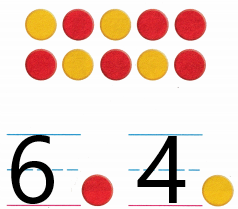
Explanation:
I counted the different colored counters, there are 6 red counters and 4 yellow counters.
Pick A Project
Directions Say: You will choose one of these projects. Look at picture A. Think about this question: How many eggs do hens lay? If you choose Project A, you will act out egg collecting. Look at picture B. Think about this question: Are flowers the only plants you can grow in a garden? If you choose Project B, you will make a garden poster.

Directions Say: You will choose one of these projects. Look at picture C. Think about this question: What do you see in the sky at night? If you choose Project C, you will create a star drawing. Look at picture D. Think about this question: Would you like to live in this house? If you choose Project D, you will draw a tree house.

Lesson 8.1 Decompose 5 to Solve Problems
Solve & Share
Directions Say: Alex plants 5 daisies in a flowerpot. Some are yellow. Some are red. Use counters to show one way to break apart a group of 5 daisies. Draw your counters on the flowerpot. Color the daisies. Complete the equation to show how many red and how many yellow daisies.
I can ……….. write equations to show parts of 5 and solve problems.

Visual Learning Bridge

Guided Practice
Directions 1 Have students listen to the story, use and draw counters, color the flowers, and complete the equation to show another way to break apart 5. Say: Carlos plants 5 flowers. Some are yellow. Some are red. How many are yellow and how many are red?
Question 1.

Answer:

Explanation:
Carlos plants 5 flowers. Some are yellow. Some are red. I draw counters, colored 2 flowers yellow and 3 flowers red , and completed the equation 5=2+3 to show another way to break apart.
Directions 2 and 3 Have students listen to the story, use and draw counters, color the flowers, and complete the equation to model other ways to break apart 5. Say: Marta plants 5 flowers. Some are yellow. Some are red. How many are yellow and how many are red?
Question 2.

Answer:

Explanation:
Marta plants 5 flowers. Some are yellow. Some are red. I draw counters, colored 3 flowers yellow and 2 flowers red , and completed the equation 5=3+2 to show another way to break apart.
Question 3.

Answer:

Explanaton:
Marta plants 5 flowers. Some are yellow. Some are red. I draw counters, colored 4 flowers yellow and 1 flowersred , and completed the equation 5=4+1 to show another way to break apart.
Independent Practice
Directions 4 Have students listen to the story, use and draw counters, color the flowers, and complete the equation to show another way to break apart 5. Say: Carlos plants 5 flowers. Some are yellow. Some are red. How many are yellow and how many are red? 5. Higher Order Thinking Have students draw another way to break apart 5 with flowers, and then write an equation to match the story and show the parts that equal 5.
Question 4.

Answer:

Explanation:
Carlos plants 5 flowers. Some are yellow. Some are red. I draw counters, colored 2 flowers yellow and 3 flowers red , and completed the equation 5=2+3 to show another way to break apart.
Question 5.

Answer:

Explanation:
I draw a way to break apart 5 with flowers, i drew 2 yellow flowers and 3 red flowers and then wrote an equation 5=2+3 to match the story and show the parts that equal 5.
Lesson 8.2 Related Facts
Solve & Share
Directions Say: 4 penguins play outside. 2 penguins go in the ice cave. How many penguins are left outside? Draw a circle around the equation that matches the story. Tell how you know.
I can … solve related addition and subtraction equations.
I can also make sense of problems.

Visual Learning Bridge

Guided Practice
Directions 1 Vocabulary Have students listen to each story and use connecting cubes to help act out each story to choose an operation. Then have students complete the equations to tell the related facts. Say: 4 penguins are in a group. 1 joins them. How many penguins are there in all? Then say: 5 penguins are in a group. 1 leaves. How many penguins are left?
Question 1.

Answer:

Explanation:
4 penguins are in a group. 1 joins them. 4+1=5, 5 penguins are there in all
5 penguins are in a group. 1 leaves. 5-1=4, 4 penguins are left.
Directions 2 and 3 Have students use cubes for these facts with 4. Have them decide whether the cubes show addition or subtraction. Encourage students to make up their own stories to match the cubes. Then have them write equations to tell the related facts.
Question 2.

Answer:

Explanation:
3 flowers are joined to 1 flower so, there are 4 in all
3 flowers are taken out from 4 flowers so, 1 is left
The equations are 1+3=4 and 4-3=1.
Question 3.

Answer:

Explanation:
2 balls are taken out from 4 balls so, 2 are left
2 balls are joined to 2 balls so, there are 4 in all
The equations are 4-2=2 and 2+2=4.
Independent Practice
Directions 4 Have students listen to each story, use cubes to help act out each story to choose an operation, and then write the equations to tell the related facts. Say: 2 bears are in a group. 3join them. How many bears are there in all? Then say: 5 bears are in a group. 3 leave. How many bears are there now? 5 Higher Order Thinking Have students decide whether the first set of cubes shows addition or subtraction, and then write an equation to match. For the second set of cubes, students color the cubes using the same numbers as the equation they just wrote, draw an arrow to tell the related fact, and then write the equation to match.
Question 4.

Answer:
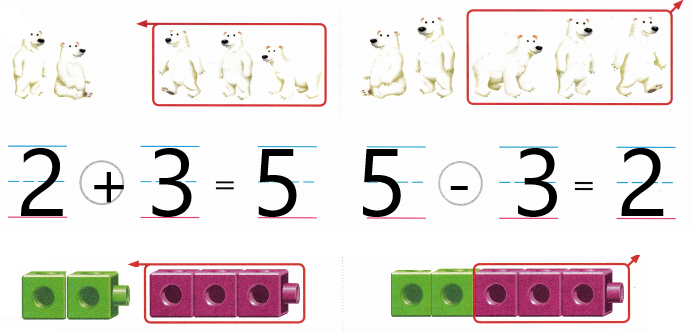
Explanation:
2 bears are in a group. 3join them. 2+3=5, 5 bears are there in all
5 bears are in a group. 3 leave. 5-3=2, 2 bears are there now.
Question 5.

Answer:

Explanation:
The first equation 1+4=5 is addition, 4 cubes joined 1 cube.
Another equation with same numbers is 5-4=1. I colored the cubes and put an arrow to show that the cubes are taken away from the group.
Lesson 8.3 Problem Solving
Reasoning
Solve & Share
Directions Say: Jada and Carlos are at the zoo. Each of them tells a story about an animal in a habihat. How could you tell a story to match the equation shown? Tell your story to a partner.Draw a picture to show your story.
I can … reason about numbers and operations.

Visual Learning Bridge

Guided Practice
Directions 1 Have students tell a story for 4 – 1. Then have them draw a picture to illustrate their story and write the equation.
Question 1.

Answer:

Explanation:
There are 4 fishes in a group, 1 is taken away. therefore, 3 are left. Equation is 4-1=3.
Independent Practice
Directions Have students tell a story for: 2 1+ 3 turtles. Then have them draw a picture to illustrate their story and write the equation; 3 3-2 snakes. Then have them draw a picture to illustrate their story and write the equation.
Question 2.

Answer:

Explanation:
A group of 3 turtles are joined with 1 turtle. There are 4 turtles now. Equation is 1+3=4.
Question 3.

Answer:

Explanation:
There are 3 snakes and 1 is taken away. 2 snakes are left. Equation is 3-1=2.
Problem Solving
Performance Task
Directions Read the problem to students. Then have them use multiple problem-solving methods to solve the problem. Say: Carlos’s teacher wrote this equation on the chalkboard: 4 + ☐ = 5. Can you tell a story for that equation? 4 Reasoning What story can you tell to help solve the problem and write the equation? 5 Use Tools Does drawing a picture help to solve the problem? What does your picture show? What other tools can you use to solve the problem? 6 Model Can a model help you solve the problem? Use the part-part model to check your answer.
4, 5, 6

Answer:

Explanation:
The missing number in the above equation is 1. The equation is 4+1=5.
Lesson 8.4 Fluently Add and Subtract to 5
Solve & Share
Directions Say: Help Jada write 2 more addition equations and 2 more subtraction equations using the numbers at the top of the page. Explain your equations using counters.
I can ………. write addition and subtraction equations within 5 and remember them.

Visual Learning Bridge

Guided Practice
Directions 1 and 2 Have students solve the equation any way they choose, and then tell how they solved the problem.
Question 1.

Answer:

Explanation:
I solved the equation by drawing counters. 1 joined 4, 4+1=5.
Question 2.

Answer:
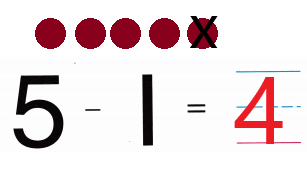
Explanation:
I solved the equation by drawing counters. 1 is taken away from 5, 5-1=4.
Directions 3 – 8 Have students solve the equation any way they choose, and then tell how they solved the problem.
Question 3.

Answer:

Explanation:
I solved the equation by drawing counters. 1 joined 2, 2+1=3.
Question 4.

Answer:

Explanation:
I solved the equation by drawing counters. 1 is taken away from 3, 3-1=2.
Question 5.

Answer:

Explanation:
I solved the equation by drawing counters. 2 is taken away from 2, 2-2=0.
Question 6.

Answer:

Explanation:
I solved the equation by drawing counters. 4 joined 1, 1+4=5.
Question 7.

Answer:

Explanation:
I solved the equation by drawing counters. 0 joined 4, 4+0=4.
Question 8.

Answer:

Explanation:
I solved the equation by drawing counters. 2 is taken away from 4, 4-2=2.
Independent Practice
Directions 9 – 13 Have students solve the equation any way they choose, and then tell how they solved the problem. 14 Higher Order Thinking Have students solve for the missing number in the equation any way they choose, and then tell how they solved the problem.
Question 9.

Answer:

Explanation:
I solved the equation by drawing counters. 1 is taken away from 4, 4-1=3.
Question 10.

Answer:

Explanation:
I solved the equation by drawing counters. 3 joined 1, 3+1=4.
Question 11.

Answer:

Explanation:
I solved the equation by drawing counters. 2 is taken away from 3, 3-2=1..
Question 12.

Answer:

Explanation:
I solved the equation by drawing counters. 0 joined 1, 1+0=1.
Question 13.

Answer:

Explanation:
I solved the equation by drawing counters. 2 is taken away from 5, 5-2=3.
Question 14.

Answer:

Explanation:
I solved the equation by drawing counters. 0 is taken away from 5, 5-0=5.
Lesson 8.5 Decompose 6 and 7 to Solve Problems
Solve & Share
Directions Say: Jada has 6 books she wants to break apart into 2 groups and place on her book shelves. Draw one way she could put her books away, and then write the numbers to tell how many books you drew on each shelf. Write an equation to match what you drew. Explain why your answer is correct.
I can … write equations to show parts of 6 and 7 and solve problems.
I can also model with math

Visual Learning Bridge

Guided Practice
Directions 1 Have students listen to the story, use the cubes to tell how many flowers are in each vase, and then complete the equation to match the cubes. Say: Jada has 7 flowers. She puts some in a blue vase and some in a red vase. How many flowers did she put in each vase?
Question 1.

Answer:

Explanation:
Jada has 7 flowers. She puts some in a blue vase and some in a red vase. There are 6 blue cubes and 1 red cube and i wrote the equation 7=6+1.
Directions 2 – 4 Have students listen to the story, use and color cubes to show 3 different ways you can break apart the flowers and put them in the vases, and then complete the equations to match each way. Say: Carlos has 7 flowers. He wants to put some in a red vase and some in a blue vase. How many flowers can he put in each vase?
Question 2.

Answer:

Explanation:
Carlos has 7 flowers. He wants to put some in a red vase and some in a blue vase. In one way he can put 3 flowers in red vase and 4 flowers in blue vase and the equation that matches with the flowers is 7=3+4.
Question 3.

Answer:

Explanation:
Carlos has 7 flowers. He wants to put some in a red vase and some in a blue vase. In one way he can put 4 flowers in red vase and 3 flowers in blue vase and the equation that matches with the flowers is 7=4+3.
Question 4.

Answer:

Explanation:
Carlos has 7 flowers. He wants to put some in a red vase and some in a blue vase. In one way he can put 2 flowers in red vase and 5 flowers in blue vase and the equation that matches with the flowers is 7=2+5.
Independent Practice
Directions 5 and 6 Have students listen to the story, use and color cubes to show different ways you can break apart the flowers and put them in the vases, and then complete the equations to match each way. Say: Daniel has 6 flowers. He puts some in a red vase and some in a blue vase. How many flowers could he put in each vase? 7 Higher Order Thinking Have students draw cubes to show another way to solve the problem, and then write an equation to match.
Question 5.

Answer:

Explanation:
Daniel has 6 flowers. He puts some in a red vase and some in a blue vase. In one way he can put 2 flowers in red vase and 4 flowers in blue vase and the equation that matches with the flowers is 6=2+4.
Question 6.

Answer:

Explanation:
Daniel has 6 flowers. He puts some in a red vase and some in a blue vase. In one way he can put 3 flowers in red vase and 3 flowers in blue vase and the equation that matches with the flowers is 6=3+3.
Question 7.

Answer:

Explanation:
I drew another way to show 6 cubes, colored 4 red and 2 blue and wrote an equation that matches that is 6=4+2.
Lesson 8.6 Decompose 8 and 9 to Solve Problems
Solve & Share
Directions Say: 8 children are going rafting. They need life jackets. Some of the life jackets are red. Some are blue. How many of each color will they need if everyone has a life jacket? Use cubes to model one way to break apart 8 and show how many are red and how many are blue. Complete the equation to match the cubes.
I can ………… write equations to show parts of 8 and 9 and solve problems.

Visual Learning Bridge

Guided Practice
Directions 1 Have students listen to the story, use and color cubes to tell how many of each color, and then complete the equation to show another way to break apart 9. Say: 9 children are going to ride a boat. They need life jackets. Some of the jackets are red and some are blue. How many of each color will they need if everyone has a life jacket?
Question 1.

Answer:

Explanation:
9 children are going to ride a boat. They need life jackets. Some of the jackets are red and some are blue. They need 8 blue jackets and 1 red jacket. The equation is 9=8+1.
Directions 2 – 4 Have students listen to the story, use and color cubes to tell how many of each color, and then complete the equations to match the cubes and model 3 more ways to break apart 8. Say: 8 children are going to ride a boat. They need life jackets. Some of the jackets are red and some are blue. How many of each jacket will they need if everyone has a life jacket?
Question 2.

Answer:

Explanation:
8 children are going to ride a boat. They need life jackets. Some of the jackets are red and some are blue. They need 3 red jackets and 5 blue jackets. The equation is 8=3+5.
Question 3.

Answer:

Explanation:
8 children are going to ride a boat. They need life jackets. Some of the jackets are red and some are blue. They need 4 red jackets and 4 blue jackets. The equation is 8=4+4.
Question 4.

Answer:

Explanation:
8 children are going to ride a boat. They need life jackets. Some of the jackets are red and some are blue. They need 5 red jackets and 3 blue jackets. The equation is 8=5+3.
Independent Practice
Directions 5 and 6 Have students listen to the story. Then have them use and color cubes to tell how many of each color. Then have them complete the equations to model 2 more ways to break apart 9. Say: 9 children are going to ride a boat. They need life jackets. Some of the jackets are red and some are blue. How many of each color could they have, if everyone has a life jacket? 7 Higher Order Thinking Have students draw cubes to show another way to solve the problem, and then write an equation to match.
Question 5.

Answer:

Explanation:
9 children are going to ride a boat. They need life jackets. Some of the jackets are red and some are blue. They need 7 red jackets and 8 blue jackets. The equation is 9=7+2.
Question 6.

Answer:

Explanation:
9 children are going to ride a boat. They need life jackets. Some of the jackets are red and some are blue. They need 5 red jackets and 4 blue jackets. The equation is 9=5+4.
Question 7.

Answer:

Explanation:
9 children are going to ride a boat. They need life jackets.I drew 9 cubes and colored them red and blue. Some of the jackets are red and some are blue. They need 4 red jackets and 5 blue jackets. The equation is 9=4+5.
Lesson 8.7 Ways to Make 10
Solve & Share
Directions Say: Jackson puts 10 watering cans on a shelf in the garden store. Use counters to show how Jackson could place the 10 watering cans. Then use different numbers of red and yellow counters to show other ways the cans could be placed on the shelf. Color the counters in the ten-frame red and yellow to show your favorite way.
I can ……. show how to make a group of 10.

Visual Learning Bridge

Guided Practice
Directions 1 Have students draw and color counters red and yellow to show one way to make 10, color the fireflies red and yellow to show that way, and then write the numbers.
Question 1.

Answer:

Explanation:
I drew and colored counters red and yellow to show one way to make 10 and colored 1 firefly yellow and 9 fireflies red to show that way, and then wrote the numbers 1 and 9.
Directions 2 – 4 Have students draw and color counters red and yellow to show one way to make 10, color the insects red and yellow to show each way, and then write the numbers.
Question 2.

Answer:

Explanation:
I drew and colored counters red and yellow to show one way to make 10 and colored 2 fireflies yellow and 8 fireflies red to show that way, and then wrote the numbers 2 and 8.
Question 3.

Answer:

Explanation:
I drew and colored counters red and yellow to show one way to make 10 and colored 3 fireflies yellow and 7 fireflies red to show that way, and then wrote the numbers 3 and 7.
Question 4.

Answer:

Explanation:
I drew and colored counters red and yellow to show one way to make 10 and colored 4 butterflies yellow and 6 butterflies red to show that way, and then wrote the numbers 4 and 6.
Independent Practice
Directions 5 and 6 Have students draw and color counters red and yellow to show one way to make 10, color the insects red and yellow to show each way, and then write the numbers. 7 Higher Order Thinking Have students draw a way to make 10, and then write the numbers.
Question 5.

Answer:

Explanation:
I drew and colored counters red and yellow to show one way to make 10 and colored 5 bees yellow and 5 bees red to show that way, and then wrote the numbers 5 and 5.
Question 6.

Answer:

Explanation:
I drew and colored counters red and yellow to show one way to make 10 and colored 6 houseflies yellow and 4 houseflies red to show that way, and then wrote the numbers 6 and 4.
Question 7.
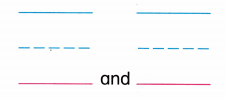
Answer:

Explanation:
I drew 7 yellow counters and 3 red counters to show one way to make 10. the numbers are 7 and 3.
Lesson 8.8 Decompose 10 to Solve Problems
Solve & Share
Directions Say: 10 children are going on a bus for a field trip. Each child will wear either a red or a yellow shirt because those are the school colors. Use counters to model a way to break 10 into two parts and show what color shirt each child wears. Then write an equation to match the counters.
I can ……. write equations to show parts of 10 and solve problems.

Visual Learning Bridge

Guided Practice
Directions 1 Have students listen to the story, use the counters to tell how many of each color, and then complete the equation to show the way 10 is separated into two parts. Say: 10 children are going on a field trip. Each child will wear either a red or a yellow shirt. How many of each color shirt will there be?
Question 1.

Answer:

Explanation:
10 children are going on a field trip. Each child will wear either a red or a yellow shirt. 8 wore yellow and 2 wore red. The equation is 10=8+2.
Directions 2 – 4 Have students listen to the story again, use and color counters to show 3 different ways to break apart 10 and tell how many of each color shirt, and then complete the equations to match their answers.
Question 2.

Answer:

Explanation:
10 children are going on a field trip. Each child will wear either a red or a yellow shirt. I colored 5 counters yellow and 5 counters red. 5 wore yellow and 5 wore red. The equation is 10=5+5.
Question 3.

Answer:

Explanation:
10 children are going on a field trip. Each child will wear either a red or a yellow shirt. I colored 4 counters yellow and 6 counters red. 4 wore yellow and 6 wore red. The equation is 10=4+6.
Question 4.

Answer:

Explanation:
10 children are going on a field trip. Each child will wear either a red or a yellow shirt. I colored 6 counters yellow and 4 counters red. 6 wore yellow and 4 wore red. The equation is 10=6+4.
Independent Practice
Directions 5 and 6 Have students use and color counters to show 2 more different ways to break apart 10 and tell how many of each color shirt for the field trip story. Then have them complete the equations to match each way. 7 Higher Order Thinking Have students color yellow and red counters in the top ten-frame to show the equation. Then have students write the related fact to the given equation, and then color yellow and red counters in the bottom ten-frame to match the equation they wrote. Have students tell how the equations are alike and different.
Question 5.

Answer:

Explanation:
10 children are going on a field trip. Each child will wear either a red or a yellow shirt. I colored 7 counters yellow and 4 counters red. 6 wore yellow and 3 wore red. The equation is 10=7+3.
Question 6.

Answer:

Explanation:
10 children are going on a field trip. Each child will wear either a red or a yellow shirt. I colored 6 counters yellow and 4 counters red. 9 wore yellow and 1 wore red. The equation is 10=9+1.
Question 7.

Answer:

Explanation:
I colored 2 counters yellow and 8 counters red in the top ten-frame to show the equation 10=2+8. Then wrote the related fact to the given equation that is 10=3+7, and then colored 3 counters yellow and 7 counters red in the bottom ten-frame to match the equation i wrote.
Lesson 8.9 Find the Missing Part of 10
Solve & Share
Directions Say: Use red and blue cubes to make two different trains. Each train should have 10 cubes. Use blue and red crayons to color the cube trains you made. Then write the missing numbers in the equation for each cube train.
I can……… find number partners for 10

Visual Learning Bridge

Guided Practice
Directions Have students: 1 count the red cubes to find one part of 10, use blue cubes to find the number under the cover, and then write the missing number in the equation to tell the parts of 10; 2 count the blue cubes to find one part of 10, use red cubes to find the number under the cover, and then write the missing number in the equation to tell the parts of 10.
Question 1.

Answer:

Explanation:
I counted the red cubes to find one part of 10, there are 5 red cubes. I used blue cubes to find the number under the cover, there are 5 blue cubes and then wrote the missing number in the equation to tell the parts of 10. The equation is 5+5=10.
Question 2.

Answer:

Explanation:
I counted the blue cubes to find one part of 10, there are 9 blue cubes. I used red cubes to find the number under the cover, there are 1 red cubes and then wrote the missing number in the equation to tell the parts of 10. The equation is 9+1=10.
Directions Have students: 3 count the red cubes to find one part of 10, use blue cubes to find the number under the cover, and then write the missing number in the equation to tell the parts of 10; 4 count the blue cubes to find one part of 10, use red cubes to find the number under the cover, and then write the missing number in the equation to tell the parts of 10; 5 and 6 count the straight fingers to find one part of 10, use their own fingers to find the other part, and then write the missing number in the equation to tell the parts of 10.
Question 3.

Answer:

Explanation:
I counted the red cubes to find one part of 10, there are 7 red cubes. I used blue cubes to find the number under the cover, there are 3 blue cubes and then wrote the missing number in the equation to tell the parts of 10. The equation is 7+3=10.
Question 4.

Answer:

Explanation:
I counted the blue cubes to find one part of 10, there are 2 blue cubes. I used red cubes to find the number under the cover, there are 8 red cubes and then wrote the missing number in the equation to tell the parts of 10. The equation is 2+8=10.
Question 5.

Answer:

Explanation:
I counted the straight fingers to find one part of 10,there are 6 straight fingers and my own fingers to find the other part, there are 4 fingers in other part of 10 and then wrote the missing number 4 in the equation to tell the parts of 10. The equation is 6+4=10.
Question 6.

Answer:

Explanation:
I counted the straight fingers to find one part of 10,there are 5 straight fingers and my own fingers to find the other part, there are 5 fingers in other part of 10 and then wrote the missing number 5 in the equation to tell the parts of 10. The equation is 5+5=10.
Independent Practice
Directions 7 – 9 Have students draw a picture to show the parts of 10, and then write the missing number in the equation to tell the parts of 10. 10 Higher Order Thinking Say: A child is holding up 3 fingers to show how old she is. What part of 10 is she showing? Use that number to write the missing numbers in the equation to tell the parts of 10.
Question 7.

Answer:

Explanation:
I colored 4 counters red and the balance 6 counters yellow. The missing number is 6 and the equation is 4+6=10.
Question 8.

Answer:

Explanation:
I colored 8 counters red and the balance 2 counters yellow. The missing number is 2 and the equation is 8+2=10.
Question 9.

Answer:

Explanation:
I colored 1 counters red and the balance 9 counters yellow. The missing number is 9 and the equation is 1+9=10.
Question 10.

Answer:

Explanation:
I counted the straight fingers to find one part of 10,there are 3 straight fingers and my own fingers to find the other part, there are 7 fingers in other part of 10 and then wrote the missing numbers 3 and 7 in the equation to tell the parts of 10. The equation is 3+7=10.
Lesson 8.10 Continue to Find the Missing Part of 10
Solve & Share
Directions Say: Jada visits a farm. The owner says there are 10 goats on the farm. Jada only sees 8 goats. How many are inside the barn? Use counters or draw pictures to show the goats that are in the barn, and then tell how you know.
I can ………… find a missing part to make 10.

Visual Learning Bridge

Guided Practice
Directions 1 – 2 Have students draw yellow counters in the ten-frame to find the missing part of 10, and then write the missing number in the equation.
Question 1.

Answer:

Explanation:
I drew 2 yellow counters in the ten-frame to find the missing part of 10, and then wrote the missing number in the equation. The equation is 8+2=10.
Question 2.

Answer:

Explanation:
I drew 5 yellow counters in the ten-frame to find the missing part of 10, and then wrote the missing number in the equation. The equation is 5+5=10.
Directions 3 – 6 Algebra Have students draw yellow counters in the ten-frame to find the missing part of 10, and then write the missing number in the equation.
Question 3.

Answer:

Explanation:
I drew 1 yellow counters in the ten-frame to find the missing part of 10, and then wrote the missing number in the equation. The equation is 9+1=10.
Question 4.

Answer:

Explanation:
I drew 6 yellow counters in the ten-frame to find the missing part of 10, and then wrote the missing number in the equation. The equation is 4+6=10.
Question 5.

Answer:

Explanation:
I drew 8 yellow counters in the ten-frame to find the missing part of 10, and then wrote the missing number in the equation. The equation is 2+8=10.
Question 6.

Answer:

Explanation:
I drew 9 yellow counters in the ten-frame to find the missing part of 10, and then wrote the missing number in the equation. The equation is 1+9=10.
Independent Practice
Directions 7 – 9 Have students draw counters in the ten-frame to show the part that they know, and then draw yellow counters in the empty spaces in the ten-frame and count to find the missing part of 10. Then have students write the missing number in the equation, 10 Higher Order Thinking Have students mark an X on the two equations that are NOT true. Then have them explain how they know which equations are true and which are NOT true.
Question 7.

Answer:

Explanation:
I drew 3 red counters to match with the part of 10 given in the question and drew 7 yellow counters in the ten-frame to find the missing part of 10, and then wrote the missing number in the equation. The equation is 3+7=10.
Question 8.

Answer:

Explanation:
I drew 5 red counters to match with the part of 10 given in the question and drew 5 yellow counters in the ten-frame to find the missing part of 10, and then wrote the missing number in the equation. The equation is 5+5=10.
Question 9.

Answer:

Explanation:
I drew 0 red counters to match with the part of 10 given in the question and drew 10 yellow counters in the ten-frame to find the missing part of 10, and then wrote the missing number in the equation. The equation is 0+10=10.
Question 10.
![]()
Answer:
![]()
Explanation:
I marked an X on the two equations that are NOT true as the sum of the two equations i marked is not equal to 10.
Topic 8 Fluency Practice Activity
Show the Letter
Directions Have students: 1 color each box that has a sum or difference that is equal to 3, 2 write the letter that they see.
I can … add and subtract fluently to 5.
Question 1.
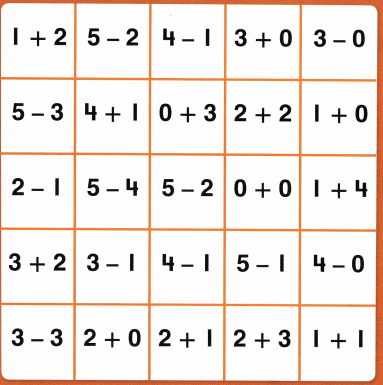
Answer:

Explanation:
I colored each box that has a sum or difference that is equal to 3.
Question 2.

Answer:
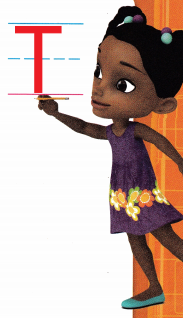
Explanation:
I colored each box that has a sum or difference that is equal to 3. I see the letter T.
Topic 8 Vocabulary Review
Directions Understand Vocabulary Have students: 1 draw a circle around the minus sign; 2 draw a circle around the sum; 3 complete the number sentence and find the difference; 4 show a way to make the number by drawing one part in the box and one part outside the box. Then have them write the numbers of the parts and fill in the operation to complete the equation.
Question 1.
10 – 5 = 5
Answer:

Explanation:
I circled the symbol minus(-).
Question 2.
6 + 3 = 9
Answer:

Explanation:
I circled the number 9 as it is the sum of 6 and 3.
Question 3.

Answer:

Explanation:
I completed the number sentence by writing minus symbol and the difference is 1.
Question 4.

Answer:

Explanation:
One way to make 9 is 4 and 5.
Topic 8 Reteaching
Directions Have students: 1 listen to the story then use and draw counters to model another way to break apart 5, and complete the equation to match the counters. Say: Emily plants 5 roses. Some are yellow. Some are red. How many are yellow and how many are red? 2 listen to the story, and then use connecting cubes to help act out the story to choose an operation. Then have students complete the equation to show the related fact for 2 + 1 = 3. 3 penguins are in a group. 1 leaves. How many penguins are left?
Set A

Question 1.
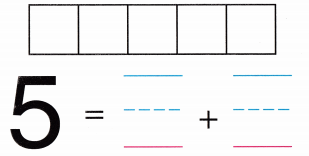
Answer:
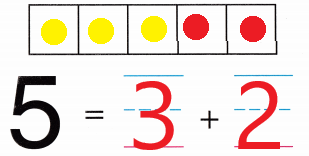
Explanation:
Emily plants 5 roses. Some are yellow. Some are red.i drew 3 counters yellow and 2 counters red to model another way to break apart 5, and completed the equation to match the counters that is 5=3+2.
Set B

Question 2.

Answer:

Explanation:
3 penguins are in a group. 1 leaves. The equation is 3-1=2. The symbol we use is minus and the difference is 2.
Directions Have students: 3 tell a story for 4-3. Then have them draw a picture to illustrate their story and write the equation, 4 solve the equation in any way they choose, and then tell how they solved the problem.
Set C

Question 3.

Answer:

Explanation:
I drew a picture show that 3 turtles leave from a group of 4 turtles and wrote the equation 4-3=1 to match with my story.
Set D

Question 4.

Answer:

Explanation:
I drew a picture to show that a group of 3 ants joined 1 ant and wrote the equation 3+1=4 to match with my story.
Directions Have students: listen to each story, use and color cubes to model other ways to break apart 7 and 9 and tell how many of each color, and then complete the equation to match the cubes. 5 Say: Jada has 7 flowers. She puts some in a red vase and some in a blue vase. How many flowers will be in each vase? 6 Say: 9 children are going to ride a boat. They need life jackets. Some of the jackets are orange and some are red. How many of each color will they need if everyone has a life jacket?
Set E

Question 5.
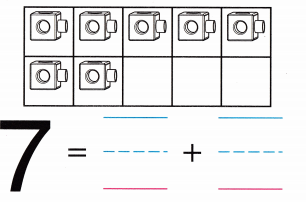
Answer:

Explanation:
Jada has 7 flowers. She puts some in a red vase and some in a blue vase. I colored 4 cubes red and 3 cubes blue. Therefore, Jada puts 4 flowres in red vase and 3 flowers in blue vase. The equation is 7=4+3.
Set F

Question 6.

Answer:
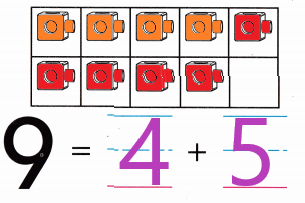
Explanation:
9 children are going to ride a boat. They need life jackets. Some of the jackets are orange and some are red.I colored 4 cubes orange and 5 cubes red to show that 4 children wore orange jackets and 5 children wore red jackets.
Directions Have students: 7 draw and color counters red and yellow to show another way to break 10 into two parts. Then complete the equation to match the counters; 8 count the green cubes to find one part of 10, use yellow cubes to find the number under the cover, and then complete the equation to show the parts of 10.
Set G

Question 7.

Answer:

Explanation:
I drew and colored 2 counters yellow and 8 counters red to show another way to break 10 into two parts. Then completed the equation to match the counters. The equation is 10=2+8.
Set H

Question 8.

Answer:

Explanation:
I counted the green cubes to find one part of 10, there are 6 green cubes and used yellow cubes to find the number under the cover, there are 4 yellow cubes and then completed the equation to show the parts of 10. The equation is 6+4=10.
Topic 8 Assessment Practice
Directions Have students: 1 write an equation that shows how the red and yellow counters are used to show the parts that make 10. 2 count the fruits, draw counters to show how many more fruits are needed to make 10, and write the number that tells how many. 3 look at the picture and mark the best answer. Say: What pair of addition and subtraction equations can be used to model a story about the apples? 4 listen to the story, and then mark all the equations that show possible ways to break apart 9. Valentino buys 9 beads to make a bracelet. Some beads are blue and some are purple. How many beads of each color could Valentina use to make a bracelet that has exactly 9 beads?
Question 1.
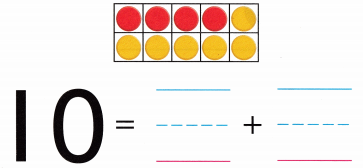
Answer:

Explanation:
I counted the red and yellow counters, there are 4 red and 6 yellow counters and wrote the equation 10=4+6.
Question 2.

Answer:

Explanation:
I counted the fruits, draw 3 counters to show how many more fruits are needed to make 10, and wrote the number 10 that tells how many.
Question 3.

Answer:
C. 5+3=8 and 8-5=3
Explanation:
The pair of addition and subtraction equations can be used to model a story about the apples is 5+3=8 and 8-5=3.
Question 4.
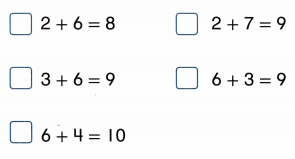
Answer:

Explanation:
Valentino buys 9 beads to make a bracelet. Some beads are blue and some are purple. Valentina can use 3 blue and 6 purple beads or 6 blue and 3 purple beads to make a bracelet that has exactly 9 beads.
Directions Have students: 5 use yellow and red counters to show a way the 5 snails can be separated into 2 groups, draw circles around two groups of snails to show a number pair that matches the counters, and then complete the equation to show the way to make 5; 6 look at the pictures as they listen to each story, use connecting cubes to act out each story and choose an operation, and then write the equations to show the related facts. Say: 2 penguins are in a group. 3 join them. How many penguins are there in all? Then say: 5 penguins are in a group. 3 leave. How many penguins are left? 7 tell a story for 5-4. Then have them draw a picture to illustrate their story and write the equation.
Question 5.

Answer:

Explanation:
I used 3 red counters and 2 yellow counters to show a way the 5 snails can be separated into 2 groups, drew circles around two groups of snails to show a number pair that matches the counters, and then completed the equation 5=3+2 to show the way to make 5
Question 6.

Answer:

Explanation:
2 penguins are in a group. 3 join them. 5 penguins are there in all, 5 penguins are in a group. 3 leave. 2 penguins are left.
The equations are 2+3=5 and 5-3=2.
Question 7.

Answer:

Explanation:
I drew a picture show that 3 snails leave from a group of 5 snails and wrote the equation 5-3=2 to match with my story.
Directions Have students: 8 draw a circle around two groups of cars to show number pairs tomó, and then complete the equation to match the picture and show the way to make 6; 9 draw o circle around two groups of onions to show number polis for 8, and then complete the equation to match the picture and show the way to make 8; 10 look at the picture and listen to the story, draw circles to show how to break apart 5 flowers, and then write the numbers in the equation to match the circled groups of flowers in the picture. Marco has 5 flowers, He gives some to his mom and same to his grandmother. How many flowers does he give to his morn? How many does he give to his grandmother
Question 8.

Answer:

Explanation:
I drew a circle around 3 cars each to show number pairs to make 6, and then completed the equation 6=3+3 to match the picture and show the way to make 6.
Question 9.

Answer:

Explanation:
I drew a circle around 6 onions and 2 onions each to show number pairs to make 8, and then completed the equation 8=6+2 to match the picture and show the way to make 8.
Question 10.

Answer:

Explanation:
I drew circle around 3 flowers and 2 flowers each to show that Marco gave 3 flowers to his mom and 2 to his grandmother. The equation that matches with the picture is 5=3+2.
Directions Have students: 11 count the red cubes to find one part of 10, use blue cubes to find the number under the cover, and then complete the equation to show the parts of 10; 12 use red and blue crayons to color the cube train to show a way 10 can be separated into parts. Then have them complete the equation to match their picture and show each part of 10; 13 draw yellow counters in the ten-frame to show the missing part of 10. Then have them complete the equation to match the picture.
Question 11.

Answer:

Explanation:
I counted the red cubes to find one part of 10, there are 7 red cubes. I used blue cubes to find the number under the cover, there are 3 blue cubes and then wrote the missing number in the equation to tell the parts of 10. The equation is 7+3=10.
Question 12.

Answer:

Explanation:
I used red and blue crayons to color 9 cubes red and 1 cube blue in the cube train to show a way 10 can be separated into parts. Then completed the equation to match their picture and show each part of 10. The equation is 10=9+1.
Question 13.

Answer:

Explanation:
I drew 8 yellow counters in the ten-frame to find the missing part of 10, and then wrote the missing number in the equation. The equation is 2+8=10.
Topic 8 Performance Task
Directions Fern’s Farmstand Say: Fern sells different fruits and vegetables at her farmstand. Have students look at the: 1 carrots and cucumbers Fern has at her farmstand, and then write two equations to describe them; 2 lettuce and radishes Fern has at her farmstand, and then write an equation to describe them; 3 red and green peppers that Fern is selling at her farmstand. Have students tell a story about them, and then write the missing numbers in the equation for their story. Then have students write the missing numbers in the other three equations.

Question 1.

Answer:

Explanation:
I saw carrots and cucumbers Fern has at her farmstand, and then wrote two equations to describe them that is 7=5+2 and 7=2+5.
Question 2.

Answer:

Explanation:
I saw lettuce and radishes Fern has at her farmstand, and then wrote an equation to describe them that is 6=3+3.
Question 3.

Answer:

Explanation:
I saw red and green peppers that Fern is selling at her farmstand.There are 3 red peppers and 2 green peppers. I wrote the missing numbers 3 and 2 in the equation for my story. Then wrote the missing numbers in the other three equations.
They are 5-3=2, 2+3=5 and 5-2=3.
Directions Have students: 4 listen to the story, draw pictures to show two ways to break apart 9 and solve the problem, and then complete the equations to match. Fern grows tomatoes for her farmstand. She grows red tomatoes and yellow tomatoes. How many tomatoes of each color should she put in her farmstand so that she has exactly 9 tomatoes in her farmstand? 5 listen to the story, draw counters to complete the model, and then write an equation to solve the problem. Fern has 10 onions in her farmstand. H of them are on one side of the farmstand. How many are on the other side?
Question 4.

Answer:

Explanation:
I drew pictures to show that Fern grows tomatoes for her farmstand. She grows red tomatoes and yellow tomatoes.
She should put in her farmstand 4 red and 5 yellow tomatoes or 5 red and 4 yellow tomatoes so that she has exactly 9 tomatoes in her farmstand. I wrote the equations 9=4+5 and 9=5+4 to show the numbe rof tomatoes she should put in farmstand.
Question 5.

Answer:

Explanation:
Fern has 10 onions in her farmstand. 4 of them are on one side of the farmstand. I drew 6 yellow counters to complete the 10- frame. The equation is 4+6=10.